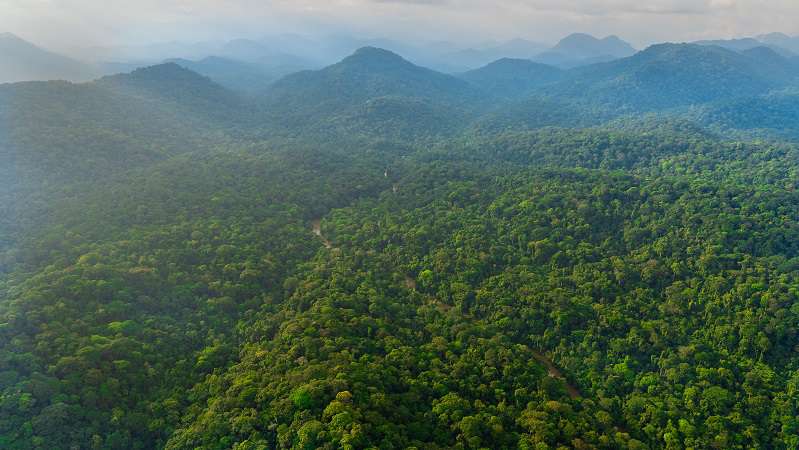A forest can be defined as a biotic community predominant of trees, shrubs or any other woody vegetation usually in a closed canopy. It is derived from latin word ‘foris’ means ‘outside’.
India’s Forest Cover is 6,76,000 sq.km (20.55% of geographic area). Scientists estimate that India should ideally have 33% of its land under forests. Today we only have about 12% Thus we need not only to protect our existing forests but also to increase our forest cover.
Forest Functions :
I. Protective and ameliorative functions.
II. Productive functions
III. Recreational and educational functions
IV. Development functions
I. Protective and ameliorative functions
A. Watershed protection
Reducing the rate of surface run-off of water by increasing infighter from rate.
Preventing flash floods and soil erosion
Producing prolonged gradual run-off and thus safeguarding against drought.
B. Erosion control
Holding soil (by preventing rain from directly washing soil away)
C. Land bank
Maintaining soil nutrients and structure.
D. Atmospheric regulation
Absorption of solar heat during evapotranspiration
Maintaining carbon dioxide levels for plant growth
Maintaining the local climatic conditions
II. Productive Functions
Local use – Consumption of forest produce by local people who collect it for
sustenance
Food: (consumptive use) gathering plants, fishing, hunting from the forest.
Fodder for cattle
Fuel wood and charcoal for cooking and heating
Poles for building homes in rural and wilderness areas
Timber for house hold articles and construction
Fiber for weaving baskets, ropes, nets, strings, etc.,
Sericulture for silk
Apiculture for rearing bees for honey (bees as pollinators)
Medicinal plants for traditional medicines, investigating them as potential source for new modern drugs Market use (productive use) Most of the products used for consumptive purposes and good source of income for supporting their livelihood of forest dwelling people.
Minor forest products (NTFPs): Fuel wood, fruits, gum, fiber, etc which are collected and solid in local markets as a source of income for forest dwellers
Major timber extraction for construction, industrial uses, paper pulp etc. Timber
extraction is done in India by the forest department, but illegal logging continues in many of the forests of India and the world.
III. Recreational And Educational Functions: Eco tourism
IV. Developmental Functions
Employment functions
Revenue
Ecological significance of forests:
1. Balances CO2 and O2 levels in atmosphere.
2. Regulates earth temperature and hydrological cycle
3. Encourage seepage and reduces runoff losses, prevents drought
4. Reduces soil erosion (roots binding), prevents siltation of reservoirs and landslides thereby floods
5. Litter helps in maintaining soil fertility
6. Safe habitat for birds, wild animals and organisms against wind, solar radiation and rain
Deforestation:
Deforestation refers to the loss of forest cover; land that is permanently converted from forest to agricultural land, golf courses, cattle pasture, home, lakes or desert. The FAO ( Food and Agriculture Organization of the UN) defines tropical deforestation as “change of forest with depletion of tree grown cover more than 90%” depletion of forest tree crown cover less than 90% is considered forest degradation
.Causes for Deforestation:
1. Agriculture: Conversion of forests to agricultural land to feed growing numbers of people
2. Commercial logging: (which supplies the world market with woods such as meranti, teak, mahogany and ebony) destroys trees as well as opening up forest for agriculture. Cutting of trees for fire wood and building material, the heavy lopping of foliage for fodder and heavy grazing of saplings by domestic animals like goats.
3. The cash crop economy: Raising cash crops for increased economy.
4. Mining
5. Increase in population: The needs also increase and utilize forest resources.
6. Urbanization & industrialization
7. Mineral exploration
8. Construction of dam and reservoirs
9. Infrastructure development
10. Forest fires
11. Human encroachment & exploitation
12. Pollution due to acid rain
Environmental effects /Consequences of deforestation
1. Food problems
2. Ecological imbalance
3. Increasing CO2
4. Floods leading to soil erosion
5. Destruction of resources
6. Heavy siltation of dams
7. Changes in the microclimate
8. Loss of biodiversity
9. Dessication of previously moist forest soil
10. Heavy rainfall and high sunlight quickly damage the topsoil in clearings of the tropical rainforests. In such circumstance, the forest will take much longer to regenerate and the land will not be suitable for agricultural use for quite some time.
11. Where forests are replanted, their replacement can mean a loss of quality
12. Loss of future markets for ecotourism. The value of a forest is often higher when it is left standing than it could be worth when it is harvested.
13. Some indigenous peoples’ way of life and survival are threatened by the loss of forests. Fewer trees results an insecure future for forest workers
14. Deforestation can cause the climate to become extreme in nature. The occurrence and strength of floods and droughts affecting the economy.
15. The stress of environmental change may make some species more susceptible to the effect of insects, pollution, disease and fire
16. Most humid regions changes to desert
17. Environmental pollution
18. Global warming
Conservation Conservation derived from two Latin words, con – together,- servare – to keep or guard measures, i.e. an act of preservation or to keep together .
Concepts in conservation
1. Restraining cutting of trees and submerging the forests
2. Reforestation
3. Afforestation
4. Control forest diseases and forest fire
5. Recycling forest products
6. Replacing forest products
7. Avoids diversion of forest lands for other activities through acts like Forest Conservation Act and Wild life (protection) Act
8. Bringing awareness among people ex: Chipko movement, Appiko , Narmada Bachao Andolan
9. Implementing people’s participatory programmes. Ex: Joint Forestry Manangement (JFM)
Deforestation Afforestration –Planting of saplings
Department of Environmental Science &
Technology,College of Agriculture
Joint Forest Management (JFM)
The need to include local communities in forest managenet has become a growing concern. Local people will only support greening an area if they can see some economic benefits from conservation. An informal arranagement between local communities and the forest department began in 1972, in the Midnapore district of West Bengal. JFM has now evolved into a formal agreement which identifies and respects the local community’s right and benefits that they need from forest resources. Under JFM schemes, forest protection communities (FPCs) from local community members are formed. They participate in restoring the green cover and protect the area from being over – exploited.
Realising this, the MoEF formulated the National Forest Policy of 1988 to give
added importance to joint forest management (JFM), which co-opts the local village communities and the forest department to work together to sustainable management of ourforests. Another resolution in 1990 provided a formal structure for communityparticipation through the formation of village forest communities (VFS). Based on this experience, new JFM guidelines were issued in 2000 which stipulated that at least 25%of the income from the area must go to the community. From the initiation of the program until 2002, there were 63,618 JFM communities managing over 140,953 sq km of forest under JFM in 27 states in India.The various states have tried a variety of approaches to JSM. The share of profits for the VFCs ranges from 25% in Kerala to at 100% in Andhra Pradesh, 50% in Gujrat,Maharastra, Odisha and Tripura. In many states, 25% of the revenue is used for village development. In many states, non-timber forest products (NTFPS) are available to the people free of cost. Some states have stopped grazing completely. While others have rotational grazing schemes that have helped in forest regeneration.(from Barucha)
Case Study: Chipko Movement From Barucha
About 300 years ago, a ruler in Rajasthan decided to fell the ‘khejri’ trees in his state to create lime. Local women led by a Bishnoi woman, Amrita Devi, clung to the trees to prevent the felling of the trees that formed the basis of the scarce resources on which they were dependent. The women were ruthlessly massacred. It is said that the ruler later realised his mistake. The story, however, has been remembered and was revived in the 1970s when severe tree-felling for timber in the Himalayas prompted local women, supported by people such as Sundertat Bahuguna and Chandi Prasad Bhat, led a people’s movement to prevent deforestation by timber contractors. They named their movement the ‘Chipko’ movement in memory of the event during which women had clung to their trees and given up their lives. The movement followed the path the 300 Bishnoi women had taken three centuries ago in Rajasthan. Chipko is a movement primarily begun and supported by local women in the hills of Uttarakhand and Garhwal, where the women (the traditional fuel collectors) have had to bear the brunt of deforestation. They have not only realized that their fuelwood and fodder resources have receded away from their ‘resource use areas’ around their settlements due to commercial timber extraction, but that this has led to serious floods and the loss of precious soil. Chipko activists have made long padayatras across the Himalayas protesting against deforestation. The movement has been highly successful and has been primarily supported by empowering local women’s groups, who are the most seriously affected segment. The movement has proved to the world that the forests of the hills are the life-support systems of local communities and of immense value in terms of local produce, and that the forest has less quantifiable but even more important ecological services such as soil conservation and the maintenance of the natural water regime of the whole region. The ability of local women to band together in the foothills of the Himalayas goes back to the preindependence days when women such as Miraben, a disciple of Gandhiji, moved to this region and understood that it was the deforestation that led to floods and devastation of villages in the valleys and in the Gangetic plains below. They also appreciated that substitution of oak and other broad-Leaved forests of the Himalayas with the planting of fast-growing pine for timber and resin was an ecological and social disaster which reduced the forest resources used by traditional hill communities.
MANGROVES
The word “Mangrove” is considered to be a combination of the Portuguese word “Mangue” and the English word “grove”. Mangroves are salt-tolerant plants of tropical and subtropical intertidal regions of the world. The specific regions where these plants occur are termed as ‘mangrove ecosystem’. These are classified as salt-tolerant evergreen forests, found along coastlines, lagoons, rivers or deltas in 124 tropical and subtropical countries and areas, protecting coastal areas against erosion, cyclones and wind. These are highly productive (wood, food, fodder, medicine and honey) but extremely sensitive and fragile. Besides mangroves, the ecosystem also harbours other plant and animal species. They are habitats for many animals like crocodiles and snakes, tigers, deer, otters, dolphins and birds. A wide range of fish and shellfish also depends on these coastal forests and mangroves help to protect coral reefs against siltation from upland erosion. Indonesia,Australia,Brazil, Nigeria and Mexico together account for around 50 percent of the total global mangrove area. The total mangrove area has declined from 18.8 million ha in 1980 to 15.2 million ha in 2005. The world has lost around 3.6 million hectares (from 18.8) of mangroves since 1980, equivalent to an alarming 20 percent loss of total mangrove area according to FAO’s recent mangrove assessment study, entitled ‘The world’s mangroves 1980-2005’. The rate of mangrove loss is significantly higher than the loss of any other types of forests. If deforestation of mangroves continues, it can lead to severe losses of biodiversity and livelihoods, in addition to salt intrusion in coastal areas and siltation of coral reefs, ports and shipping lanes. Tourism would also suffer. Asia suffered the largest net loss of mangroves since 1980, with more than 1.9 million ha destroyed, mainly due to changes in land use. FAO cited high population pressure, the large-scale conversion of mangrove areas for shrimp and fish farming, agriculture, infrastructure and tourism, as well as pollution and natural disasters as the major causes for the destruction of mangroves. As the experiences have proved that the presence of mangrove ecosystems on coastline save lives and property during natural hazards such as cyclones, tsunami storm surges and erosion, the conservation efforts are given importance.
The distribution of mangrove ecosystem on Indian coastlines indicates that the
Sundarban mangroves occupy very large area followed by Andaman-Nicobar Islands and Gulf of Kachch in Gujarat. Rest of the mangrove ecosystems are comparatively smaller. Over 1600 plant and 3700 animal species have been identified from these areas. A Senior Forestry Officer reported that part of the largest mangrove area in the world, the Sundarbans Reserved Forest in Bangladesh, is well protected and no major changes in the extent of the area have occurred during the last few decades, although some damage to the mangroves was reported after the cyclone in 2007. In Ecuador, the abandoning of ponds and structures for shrimp and salt production led to a rebuilding of various mangrove sites.



Comments are closed